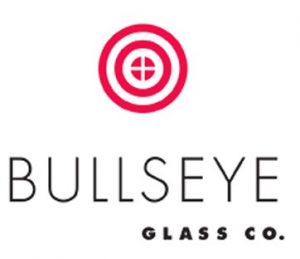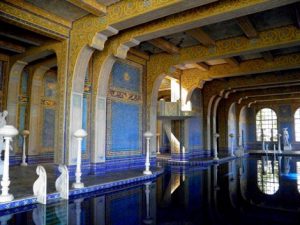OCEANSIDE COMPATIBLE, BULLSEYE COMPATIBLE, 96 COE, 90 COE












 This mosaic is giant! There are seven bays and each bay is 18’x45’. It is about 5,600 sq ft of mosaic. It made the news because it was falling apart! A team went in to asses the issues. They determined the problems were: Glass tiles were used instead of smalti, (Smalti are ½-1/3 the size of tiles but twice as thick. Smalti do have a beveled edge) the mounting of the tiles to a netting with epoxy was not the best method, the materials used were of dubious quality, the cements used to install the mosaic were not the best choice, and the methods used to apply the cement and mosaic sections were suspect and probably incorrect. Within a year of the installation glass started to fall! 50 years later the team was trying to determine the best way to fix it.
The decision was made to remove the entire mosaic and replace it with new. The design was to be reproduced and this time fabricated and installed correctly! The color palette was to remain the same, but it was allow to increased the depth of color and make some minor corrections to the design. This project is still going on. At the time of the Winter issue of Stained Glass bay two was complete and Bay 3 was underway, schedule to be complete by Easter.
This mosaic is giant! There are seven bays and each bay is 18’x45’. It is about 5,600 sq ft of mosaic. It made the news because it was falling apart! A team went in to asses the issues. They determined the problems were: Glass tiles were used instead of smalti, (Smalti are ½-1/3 the size of tiles but twice as thick. Smalti do have a beveled edge) the mounting of the tiles to a netting with epoxy was not the best method, the materials used were of dubious quality, the cements used to install the mosaic were not the best choice, and the methods used to apply the cement and mosaic sections were suspect and probably incorrect. Within a year of the installation glass started to fall! 50 years later the team was trying to determine the best way to fix it.
The decision was made to remove the entire mosaic and replace it with new. The design was to be reproduced and this time fabricated and installed correctly! The color palette was to remain the same, but it was allow to increased the depth of color and make some minor corrections to the design. This project is still going on. At the time of the Winter issue of Stained Glass bay two was complete and Bay 3 was underway, schedule to be complete by Easter.



 The next batch of numbers are Spirit glass numbers. Again just beautiful Art Glass. Rio, Valhalla, Sedona, Seattle. (and they even had cool names!!)
The next batch of numbers are Spirit glass numbers. Again just beautiful Art Glass. Rio, Valhalla, Sedona, Seattle. (and they even had cool names!!)





 In the art world the top item made is tobacco pipes, but also ornaments, pendants and other wonderful works of art!
In the art world the top item made is tobacco pipes, but also ornaments, pendants and other wonderful works of art!




 Sign up for one of our torch room classes and learn this art! https://www.stainedglassexpress.com/skins/common/images/TorchRoomClassesSchedule.pdf
Sign up for one of our torch room classes and learn this art! https://www.stainedglassexpress.com/skins/common/images/TorchRoomClassesSchedule.pdf
 This is a picture of the Roman Pool at Hearst Castle. The tile patterns were inspired by mosaics found in the 5th Century Mausoleum of Galla Placidia in Ravenna, Italy. Some also represent the marine monster themes that are in the ancient Roman baths.
The tiles are 1” square and go ceiling to floor. These glass tiles, called smalti, are either mostly colored blue or orange or are clear with fused gold inside.
This is a picture of the Roman Pool at Hearst Castle. The tile patterns were inspired by mosaics found in the 5th Century Mausoleum of Galla Placidia in Ravenna, Italy. Some also represent the marine monster themes that are in the ancient Roman baths.
The tiles are 1” square and go ceiling to floor. These glass tiles, called smalti, are either mostly colored blue or orange or are clear with fused gold inside.

 Want to see more? https://www.uvu.edu/rootsofknowledge/
Want to see more? https://www.uvu.edu/rootsofknowledge/


 As always, glass is not the easiest to photograph so these don’t particularly show the special characteristics of Corella Classic. Wissmach’s description is “In contrast to the more traditional and defined patterns, with Corella Classic the color flows across the non-directional pattern for that special illumination—A shimmering reflection of light from watery surface of glass.
On our website, Corella Classic is mixed in with the other cathedrals of Wissmach. http://www.stainedglassexpress.com/Stained-Art-Glass/Wissmach-Glass-Art-Glass/Wissmach-Glass-Cathedral
As always, glass is not the easiest to photograph so these don’t particularly show the special characteristics of Corella Classic. Wissmach’s description is “In contrast to the more traditional and defined patterns, with Corella Classic the color flows across the non-directional pattern for that special illumination—A shimmering reflection of light from watery surface of glass.
On our website, Corella Classic is mixed in with the other cathedrals of Wissmach. http://www.stainedglassexpress.com/Stained-Art-Glass/Wissmach-Glass-Art-Glass/Wissmach-Glass-Cathedral
 In the store they are in their own section of the stock glass.
In the store they are in their own section of the stock glass.
 This type of work demanded more glass of consistent quality. 1851
This type of work demanded more glass of consistent quality. 1851
 For your workspace you should be prepared to make it a fire proof space. Easily done. Flame resistant sheetrock or metal set away from the wall. Put it on something that won’t burn. Common sense kind of stuff. Don’t burn your house down.
The big difference between having a 110 line and a 220 is the depth of the kiln. When there are two elements in the kiln you can run it on a 110 line. You just have to change the outlet to accommodate the commercial plug.
For your workspace you should be prepared to make it a fire proof space. Easily done. Flame resistant sheetrock or metal set away from the wall. Put it on something that won’t burn. Common sense kind of stuff. Don’t burn your house down.
The big difference between having a 110 line and a 220 is the depth of the kiln. When there are two elements in the kiln you can run it on a 110 line. You just have to change the outlet to accommodate the commercial plug.
 Consider what you want to make. Jewelry and little dishes. You are good with a little kiln. If you think BIG, you will need a bigger kiln. Maybe one with a clamshell feature so that it opens from the top and the bottom. You can get one that bottom slides out. Features to consider when thinking about putting things in the kiln and getting them back out.
If you want to do tall things like a drape lamp shade or vase you should consider bringing in that 220 line. The 220 allows the kiln to have three elements and therefore it can be deeper.
Everyone I know, recommends upgrading to a digital controller. One where you can save multiple programs. We sell the RTC-1000 with great results. We can store 6 programs which pretty much covers everything.
What you definitely do not want is one that you have to babysit and make sure it gets turned off. You run around with a timer around your neck (seriously) and I have heard terrible results of kilns burning through when someone went to bed and forgot.
One more thing to put into your brain. If you think you ever might get into glass blowing or bead making you might consider a kiln with a punty door that you can use to anneal your beads.
Consider what you want to make. Jewelry and little dishes. You are good with a little kiln. If you think BIG, you will need a bigger kiln. Maybe one with a clamshell feature so that it opens from the top and the bottom. You can get one that bottom slides out. Features to consider when thinking about putting things in the kiln and getting them back out.
If you want to do tall things like a drape lamp shade or vase you should consider bringing in that 220 line. The 220 allows the kiln to have three elements and therefore it can be deeper.
Everyone I know, recommends upgrading to a digital controller. One where you can save multiple programs. We sell the RTC-1000 with great results. We can store 6 programs which pretty much covers everything.
What you definitely do not want is one that you have to babysit and make sure it gets turned off. You run around with a timer around your neck (seriously) and I have heard terrible results of kilns burning through when someone went to bed and forgot.
One more thing to put into your brain. If you think you ever might get into glass blowing or bead making you might consider a kiln with a punty door that you can use to anneal your beads.

 To see what Stained Glass Express offers https://www.stainedglassexpress.com/fusing_supplies/kilns-and-accessories/
To see what Stained Glass Express offers https://www.stainedglassexpress.com/fusing_supplies/kilns-and-accessories/
Just look at their thumbs! They are lined with little cuts! Right! So annoying! Comes from pushing little pieces of glass against the grinding wheel. Unlike when we started out in business in 1988, now there is a gadget for everything
Did you know we do private parties at Stained Glass Express? These are plates that were made at a bridal shower! And a picture of the surprised bride.
Have no fear if you do not have a kiln, you can rent space in our kiln.
Step 1. Drink the wine! No problem with that step, right?
Step 2. Make sure the bottle is clean and dry inside and out.
Step 3. Apply Spray A to the side of the bottle that will facing up in the kiln. Be sure there is no spray A on the bottom as it won't burn off against the shelf. Spray A is very finely ground glass suspended in a medium that burns off clean. It not only helps prevent devitrification (a scummy layer that can appear on the glass after it is fired), but it will also help to keep any painted labels that may be on the bottle from burning off during the firing process.
Step 4. Use a kiln shelf that has been coated with kiln wash or covered with fiber paper. Leave enough room around each bottle to accommodate the spread as the bottles flatten out.
Step 5. Kilns are different, so make adjustments as necessary for your kiln. 300 DPH (degrees per hour) to 1100, then soak for 30 minutes (this allows the glass, shelf and air to reach equal temperatures) 400 DPH to 1450 soak for 10 minutes or until the bottle is flat. (take a peek)
Step 6. Cool AFAP (as fast as possible) to 1050 d. We don't suggest you open the lid because of the potential to thermal shock the glass. If your kiln doesn't have a controller, turn the power off until the temperature reaches 1050. Cooling quickly through the 1200 to 1350 range also helps to eliminate devitrification.
Step 7. Hold at 1050 for 1 hour and then cool 100 DPH to 400. the annealing temperature for bottles is somewhere between 1050-850 so you want to go slowly through this range. That's it. . . you have made a great gift! Add a cheese know tied with a piece of raffia to really kick it up! You can also paint with glass paint, use decals, sandblast designs--use your imagination! We will slump your bottle for you for $10. You must have it all prepared.